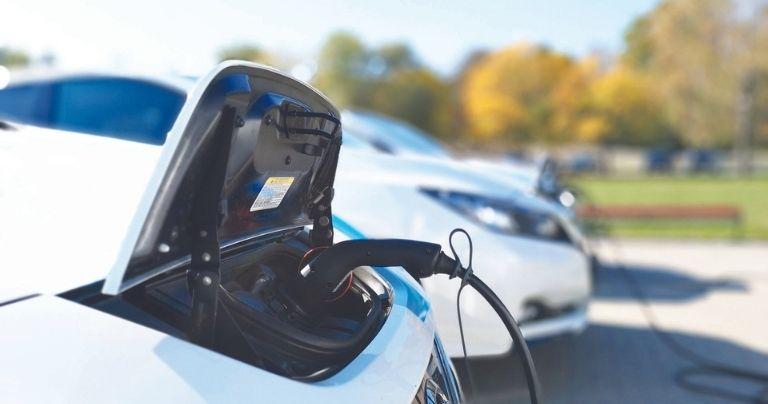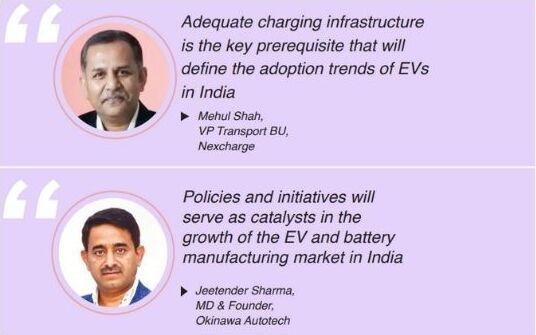Penetration of EV charging stations across India: A review
By EPR Magazine Editorial December 23, 2021 2:03 pm IST
By EPR Magazine Editorial December 23, 2021 2:03 pm IST

This article is an analysis of how well are we progressing towards expansion of EV batteries and to have an exceptional charging infrastructure across India.
The Indian electric vehicle battery market exhibited strong growth during 2015-2020. Looking forward, IMARC Group expects the market to grow at a CAGR of around 30 percent by 2026. Considering the uncertainties of Covid-19, the battery players in India are continuously tracking and evaluating the direct as well as the indirect influence of the pandemic.
Emerging trends and types of EV batteries
Lithium-ion batteries are going to be the preferred choice for electric vehicles and other types of applications in the future. According to Mehul Shah, VP Transport BU, Nexcharge, “Although most lithium-ion batteries are similar in composition, there are different types of lithium-ion batteries that are available in the market. For electric vehicles, Lithium Iron Phosphate Batteries (LFP), Lithium Nickel Manganese Cobalt Oxide (NMC), Lithium Manganese Oxide, and Lithium Titanate (LTO) and Metal Air are most commonly used.”
In addition to that, fuel cell electric vehicles (FCEVs) are also an emerging technology in the EV space and are more efficient than conventional internal combustion engine vehicles as they produce no tailpipe emissions, they only emit water vapour and warm air. FCEVs are equipped with other advanced technologies to increase efficiency; they have regenerative braking systems which help capture the energy lost during braking and store it in a battery.
According to Jeetender Sharma, MD & Founder, Okinawa Autotech, “The trajectory of battery technology development has been erratic, ranging from periods of stagnation to substantial advances. The shift away from heavy, acid batteries to small, light and significantly more efficient nickel/metal (NiMH) accumulators has been steady. The invention of lithium-ion technology was one of the key advancements. Of course, with the development of post lithium-ion technology, much more technical advancement appears to be on the horizon in the next years.”
Driving factors for EV batteries
The Indian Government is building a sustainable EV ecosystem via the National Electric Mobility Mission Plan (NEMMP) and has rolled out the Faster Adoption and Manufacturing of (Hybrid &) Electric vehicles (FAME) plan in India. In addition to this, several state transport utilities have procured over 500 electric buses in a bid to incorporate EVs into the system.
Talking about sustainability, Mehul highlights that the alarming rate of air pollution in many parts of India has attracted a lot of negative attention lately and rightly. “So, EVs are a viable solution to tackle this urgent problem and the Government of India is determined to encourage Indian consumers to opt for electric vehicles instead of conventional cars and bikes”, he explains.
Whereas, Jeetender feels “Many reasons are driving up demand for electric vehicle batteries. Automakers are pouring billions of dollars into expanding their electric vehicle lines, and sales are at an all-time high. The potential battery industry is growing tremendously due to the fast increase and acceptance of electric vehicles.”
Setting-up battery manufacturing under Make in India
The PLI scheme for manufacturing ACC aims to set up giga factories, promote exports, achieve economies of scale, produce cutting-edge high quality globally competitive products, and most importantly, it hopes to create the next wave of job growth in the energy sector. “To boost the sector, the central government gave its nod to a much-awaited PLI scheme for manufacturing Advanced Chemistry Cells (ACC) with a budgetary outlay of ₹18,100 crores”, adds Mehul.Jeetender Sharma, MD & Founder, Okinawa Autotech Adding more to the discussion Jeetender feels, “By making enterprises more internationally competitive, the Atmanirbhar Bharat initiative strives to enhance exports, realise economies of scale, and manufacture cuttingedge items. it is a win-win situation, as it will attract foreign and domestic investment as well as extra job opportunities.” These policies and initiatives will serve as catalysts in the growth of the EV and battery manufacturing market in India.
Outlook for EV battery market and charging infrastructure
The charging infrastructure is the backbone of electric mobility but it is also one of the perceived barriers to EV adoption in India, given its limited availability and long charging times. India is picking up the pace in setting up its charging infrastructure, but it lags behind the European Union (EU), USA or China. High operating costs, Discom load, and the uncertainty related to utilisation rates of charging stations are holding back charge operators from expanding their current reach.
Adequate charging infrastructure is the key prerequisite that will define the adoption trends of EVs in India, says Mehul. EVs carry limited onboard energy in their battery packs and they need charging from time to time depending upon the type of battery pack, its size and capacity. The charging requirement depends not only on the kind of vehicle—two-wheeler, three-wheeler, four-wheeler, and bus but also on the utility purpose i.e. passenger or commercial.
On this point, Jeetender notes, recent advancements such as lithium-ion batteries, fast charging, and better mileage have helped electric vehicle manufacturers to be more passenger-friendly. Therefore, the lithium-ion battery segment is expected to dominate the market over the forecast period. “The technological advancements, which have led to a sharp increase in the energy density of the lithium-ion battery market even while decreasing the overall cost of lithium-ion batteries, have enabled the increase in uptake of li-ion powered EVs”, he contemplates.
The Government of India has been supporting the EV industry through schemes such as FAME1 and FAME2 with a major focus on charging infrastructure. The industry players too have been quite optimistic and have shown an active interest in the overall EV Charging ecosystem. While EVs are being worked upon by major OEMs, an ecosystem for the development of chargers, charging stations, and other services are steadily being built.
The charging infrastructure development is taking a good pace in Indian Market. Many enterprises are investing in the same and thus giving it a great boost. While that is in the process, one can adapt to electric two-wheelers with detachable or swappable batteries. One can opt for an alternative technological solution by considering an electronic two-wheeler with swappable batteries. Today we live in a world where we can charge automobiles like smartphones and, at Okinawa, we are making it possible. So, anything is possible in this technologically advancing world scenario.
The way forward
Lithium-ion appears to be the most efficient battery technology currently available, implying that there is still room for development. They can store a lot of charges and have a lot of voltage per unit mass and volume. In terms of quality, power, half-life and cost, they also outperform earlier batteries. They have risen to the top of the EV market in the previous two decades. They’re the same advancements that allow manufacturers to reposition themselves away from fossil fuels and internal combustion engines (ICE). There has been a global shift towards electric vehicles (EVs), which is pushing lithium-ion batteries to their limits in terms of power, lifespan, and cost-effectiveness.

We use cookies to personalize your experience. By continuing to visit this website you agree to our Terms & Conditions, Privacy Policy and Cookie Policy.